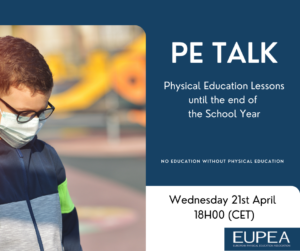 first Physical Education Talk organised by the European Physical Education Association on Wednesday 21st April 2021 6pm to 7.30pm CET.
first Physical Education Talk organised by the European Physical Education Association on Wednesday 21st April 2021 6pm to 7.30pm CET. On the programme of this evening, 4 teachers from 4 different European countries will present a synopsis of their context and PE teaching successes and challenges in their schools in response to the ever changing Covi-19 restrictions. We introduce our Physical Education teachers and their schools below. Spread the word by sharing and commenting on the Facebook event.
Heidi Rautajoki, PE teacher from Ressu Comprehensive School, Lapinlahdenkatu 10, 00180 Helsinki.
Google map link Ressun peruskoulu (Ressu Comprehensive School) ; School web page;
Context: Ressu a combined Finnish public school with IB world school curriculum implemented to the national curriculum. PYP and MYP programs. Teaching in two language streams in Finnish and in English. The school has primary classes (1-6) and upper comprehensive classes (7-9).
Finland has made regional Corona-19 solutions. Helsinki has a more serious pandemic situation compared to other regions in Finland so, after 5 weeks of distance learning since February 2021, upper comprehensive students are now doing a hybrid system for at least 3 weeks. Primary school students have stayed at school face to face through the whole academic year since August 2020.
Garrett Coyle, Secondary School PE Teacher https://stmacartanscollege.ie/ Monaghan Town, Co. Monaghan Ireland
All boys school ; Enrolment: 625
Context: Online from 11th January – 26th March 2021. Returned to face-to-face teaching for all students in recent weeks after a phased reopening prioritising older age groups. Garrett in his presentation will focus on a unit of learning on baseball that will be taught to Junior Cycle students (13015 year olds). It will highlight the safety precautions that will be in place for the safe teaching of the sport with the Covid-19 restrictions in place. He will describe how Digital Technology will be used to assist assessment.
Dr Viviana Zito PhD High School Secondary School Physical Education Teacher
Liceo Aristosseno High School. in Taranto, Southern Italy.
Context: In Italy schools opened in the middle of September 2020. They have been face to face for a maximum of 2 weeks this school year. In the Taranto Region, High schools have been online since late September 2020. At one point during the year, for a few weeks, parents were given an option to send their children to school face to face or not. A hybrid option resulted (both face to face and online) which was very challenging for teaching physical education. During the school year Medium schools were mostly both online and face to face for 50% of the lessons at the time.
Primary (until 6-10 years of age) and kindergarten (until 5 years of age) were in present i.e. face to face for all of the year with strict organisational and management systems (half the children being schooled at home and the other half online. Children then alternated with the system). For a short period of time all children at the Middle level (11-13 Years) had online/distance teaching and learning.
Overall, hybrid PE (Half the children in school face to face and the other half at home joining online) was the most challenging method of teaching for PE teachers because it is difficult to follow children at home and in the class at the same time.
Catarina Cachapuz and Rita Pacheco Secondary School Physical Education Teachers
School: AE Aurélia de Sousa: http://ae-aureliadesousa.com/ Porto Portugal
Google map location: Escola Secundária Aurélia de Sousa – Google Maps
Context: : PE and Middle Classes was a challenging year with alternative teaching modes (on-line and on-site learning) requiring teachers to constantly be available for change. In this context, the importance of collaborative work among teachers was so important. In this presentation we show the adaptation made to the standards from the General Health Office and the ways we accommodate both the guidelines of the Ministry of Education and of professional organizations, SPEF and CNAPEF. In addition to safety issues, we define the guiding principles of our planning during Covid-19 restrictions. We highlight : (1) the need to keep the students´ feeling of belonging to their class and school and how we use students´ assessment to increase learning. We share what we still hope to do in what remains of this school year.